engine coolant TOYOTA SEQUOIA 2021 (in English) User Guide
[x] Cancel search | Manufacturer: TOYOTA, Model Year: 2021, Model line: SEQUOIA, Model: TOYOTA SEQUOIA 2021Pages: 588, PDF Size: 12.76 MB
Page 420 of 588
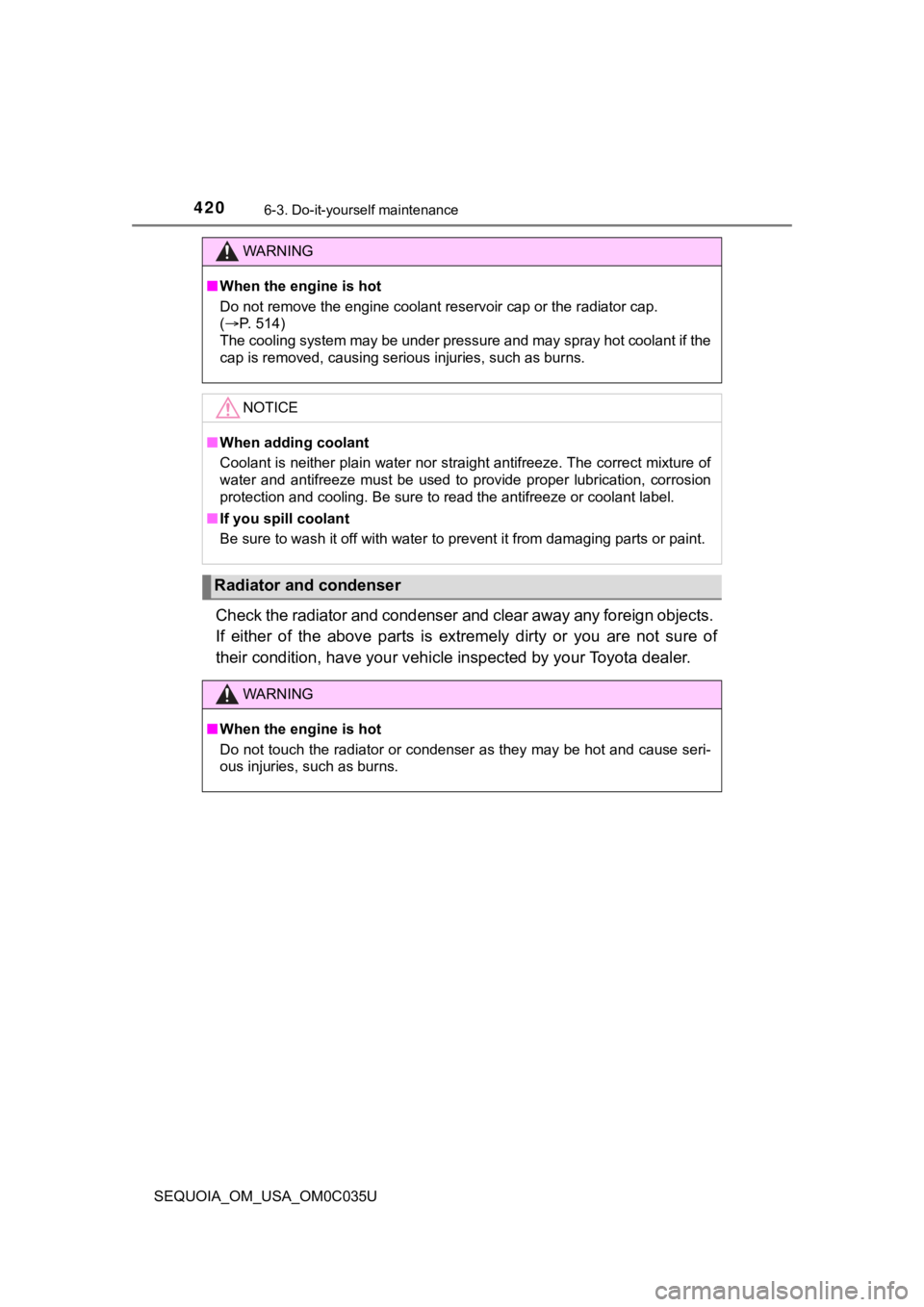
4206-3. Do-it-yourself maintenance
SEQUOIA_OM_USA_OM0C035U
Check the radiator and condenser and clear away any foreign objects.
If either of the above parts is extremely dirty or you are not sure of
their condition, have your vehic le inspected by your Toyota dea ler.
WARNING
■When the engine is hot
Do not remove the engine coolant reservoir cap or the radiator cap.
(P. 514)
The cooling system may be under pressure and may spray hot coolant if the
cap is removed, causing serious injuries, such as burns.
NOTICE
■ When adding coolant
Coolant is neither plain water nor straight antifreeze. The cor rect mixture of
water and antifreeze must be used to provide proper lubrication , corrosion
protection and cooling. Be sure to read the antifreeze or coolant label.
■ If you spill coolant
Be sure to wash it off with water to prevent it from damaging p arts or paint.
Radiator and condenser
WARNING
■When the engine is hot
Do not touch the radiator or condenser as they may be hot and c ause seri-
ous injuries, such as burns.
Page 468 of 588
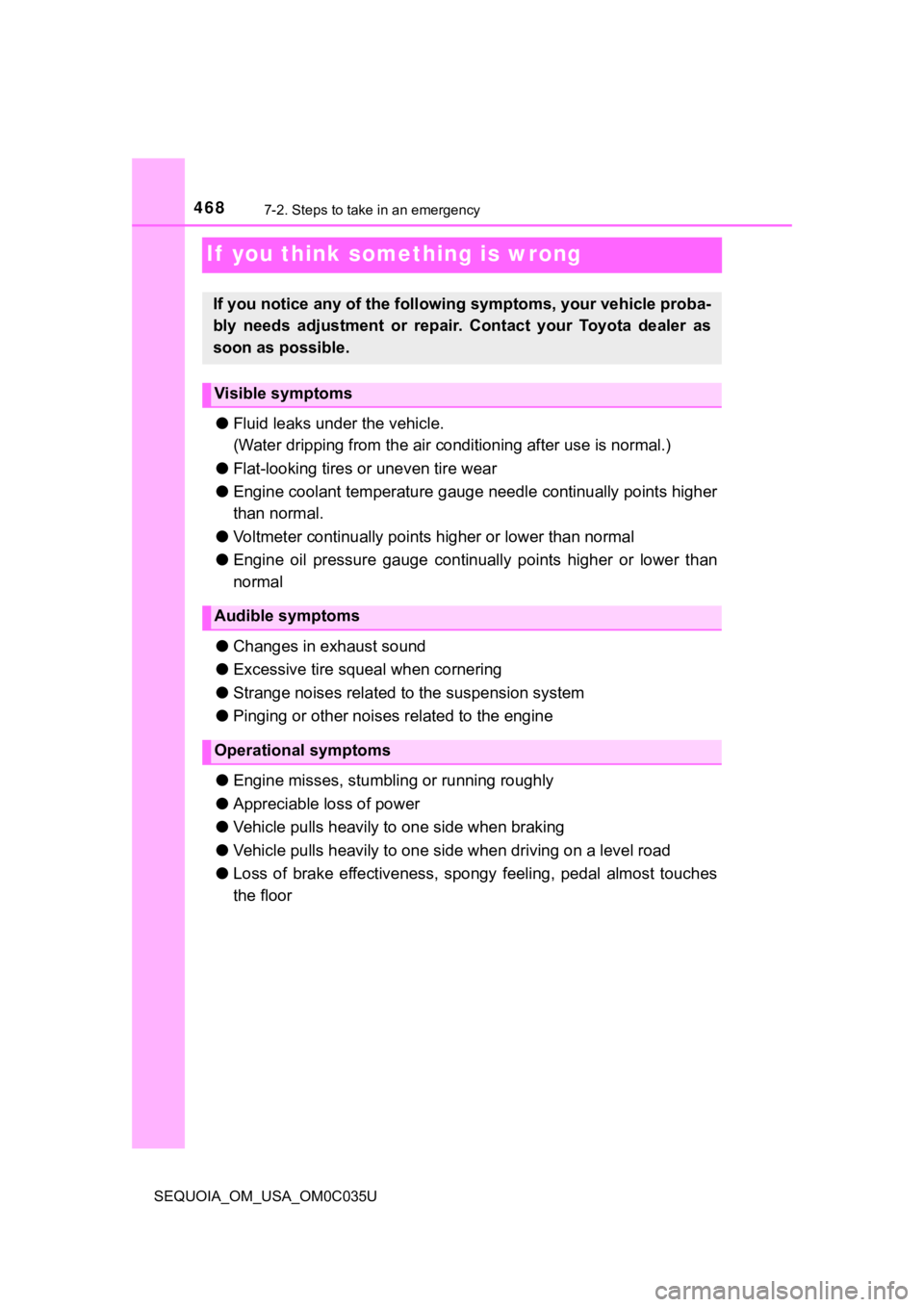
4687-2. Steps to take in an emergency
SEQUOIA_OM_USA_OM0C035U
If you think something is wrong
●Fluid leaks un der the vehicle.
(Water dripping from the air conditioning a fter use is normal.)
● Flat-looking tires or uneven tire wear
● Engine coolant temperature gauge needle continually points high er
than normal.
● Voltmeter continually points higher or lower than normal
● Engine oil pressure gauge continually points higher or lower th an
normal
● Changes in exhaust sound
● Excessive tire squeal when cornering
● Strange noises related to the suspension system
● Pinging or other noises related to the engine
● Engine misses, stumbli ng or running roughly
● Appreciable loss of power
● Vehicle pulls heavily to one side when braking
● Vehicle pulls heavily to one s ide when driving on a level road
● Loss of brake effectiveness, spongy feeling, pedal almost touch es
the floor
If you notice any of the followi ng symptoms, your vehicle proba -
bly needs adjustment or repair. Contact your Toyota dealer as
soon as possible.
Visible symptoms
Audible symptoms
Operational symptoms
Page 479 of 588
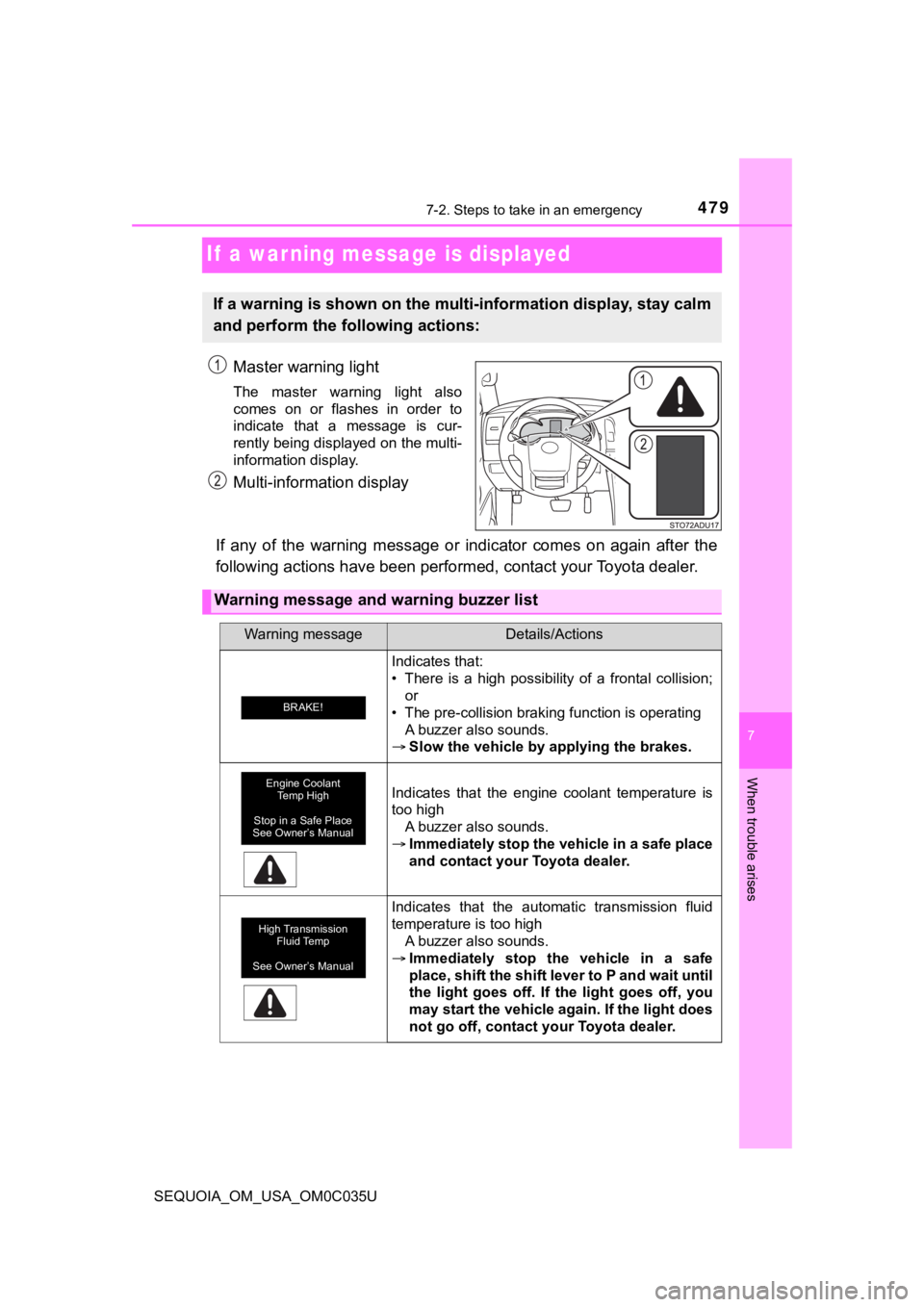
4797-2. Steps to take in an emergency
SEQUOIA_OM_USA_OM0C035U
7
When trouble arises
If a warning message is displayed
Master warning light
The master warning light also
comes on or flashes in order to
indicate that a message is cur-
rently being displayed on the multi-
information display.
Multi-information display
If any of the warning message or indicator comes on again after the
following actions have been per formed, contact your Toyota deal er.
If a warning is shown on the multi-information display, stay ca lm
and perform the following actions:
Warning message and warning buzzer list
Warning messageDetails/Actions
Indicates that:
• There is a high possibility of a frontal collision; or
• The pre-collision braking function is operating
A buzzer also sounds.
Slow the vehicle by applying the brakes.
Indicates that the engine coolant temperature is
too high
A buzzer also sounds.
Immediately stop the vehicle in a safe place
and contact your Toyota dealer.
Indicates that the automatic transmission fluid
temperature is too high
A buzzer also sounds.
Immediately stop the vehicle in a safe
place, shift the shift lever to P and wait until
the light goes off. If the light goes off, you
may start the vehicle again. If the light does
not go off, contact your Toyota dealer.
BRAKE!
Engine Coolant
Temp High
Stop in a Safe Place
See Owner’s Manual
High Transmission Fluid Temp
See Owner’s Manual
Page 513 of 588

5137-2. Steps to take in an emergency
SEQUOIA_OM_USA_OM0C035U
7
When trouble arises
If your vehicle overheats
●The needle of the engine coolant temperature gauge ( P. 9 4 )
enters the red zone o r a loss of engine power is experienced.
(For example, the vehicle speed does not increase.)
● Steam comes out f rom under the hood.
Stop the vehicle in a safe place and turn off the air condition ing sys-
tem, and then stop the engine.
If you see steam:
Carefully lift the hood after the steam subsides.
If you do not see steam:
Carefully lift the hood.
After the engine has cooled
down sufficiently, inspect the
hoses and radiator core (radia-
tor) for any leaks. Radiator
Cooling fan
If a large amount of coolant
leaks, immediately contact your
Toyota dealer.
The coolant level is satisfactory
if it is between the “FULL” and
“LOW” lines on the reservoir.Reservoir
“FULL” line
“LOW” line
Radiator cap
The following may indicate that your vehicle is overheating:
Correction procedures
1
2
3
4
Page 514 of 588
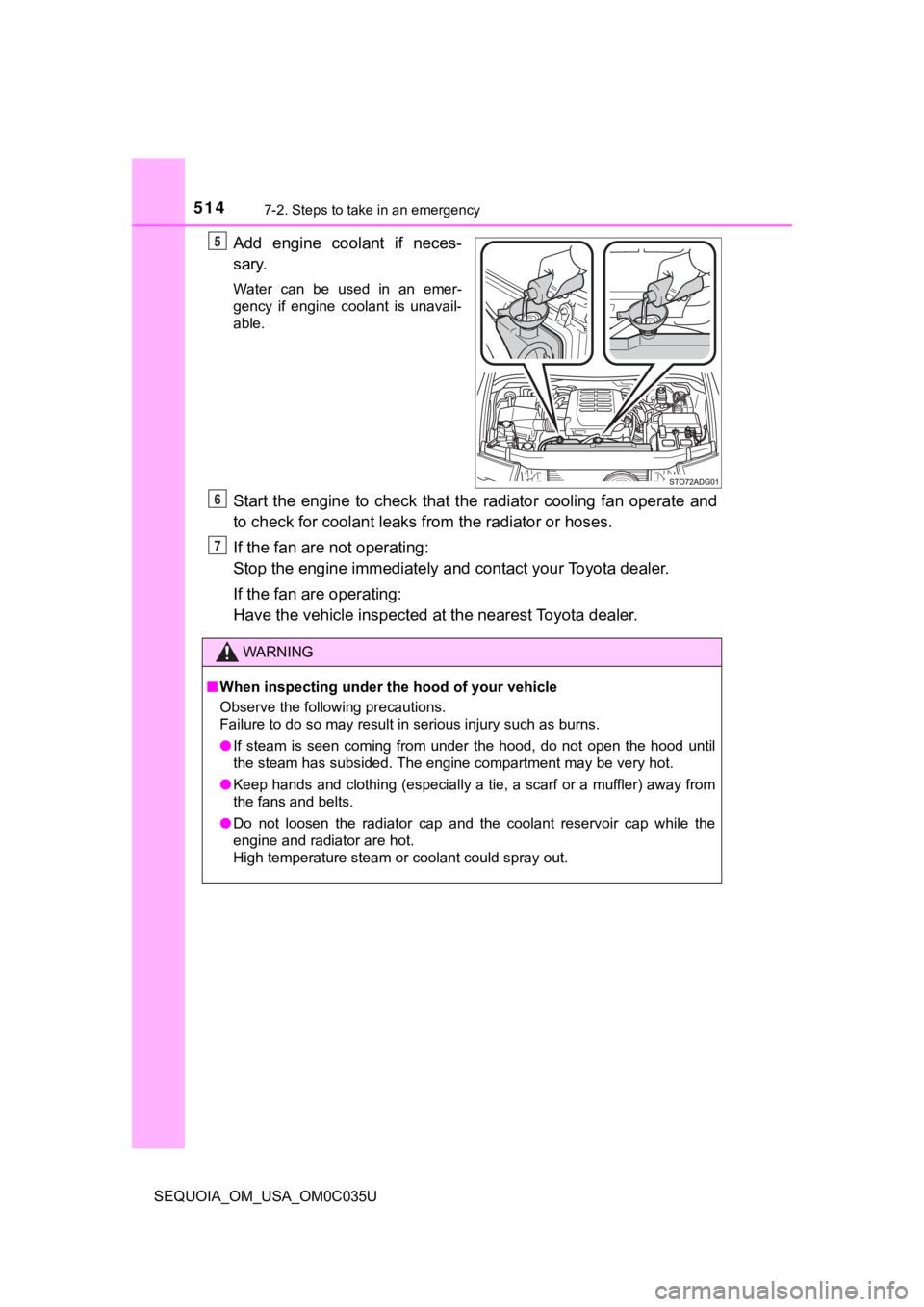
5147-2. Steps to take in an emergency
SEQUOIA_OM_USA_OM0C035U
Add engine coolant if neces-
sary.
Water can be used in an emer-
gency if engine coolant is unavail-
able.
Start the engine to check that the radiator cooling fan operate and
to check for coolant leaks from the radiator or hoses.
If the fan are not operating:
Stop the engine immediately and contact your Toyota dealer.
If the fan are operating:
Have the vehicle ins pected at the nearest Toyota dealer.
5
WARNING
■When inspecting under th e hood of your vehicle
Observe the following precautions.
Failure to do so may result in serious injury such as burns.
● If steam is seen coming from under the hood, do not open the ho od until
the steam has subsided. The engine compartment may be very hot.
● Keep hands and clothing (especially a tie, a scarf or a muffler ) away from
the fans and belts.
● Do not loosen the radiator cap and the coolant reservoir cap wh ile the
engine and radiator are hot.
High temperature steam or coolant could spray out.
6
7
Page 515 of 588

5157-2. Steps to take in an emergency
7
When trouble arises
SEQUOIA_OM_USA_OM0C035U
NOTICE
■When adding engine coolant
Wait until the engine has cooled down before adding engine cool ant.
When adding coolant, do so slowly. Adding cool coolant to a hot engine too
quickly can cause damage to the engine.
■ To prevent damage to the cooling system
Observe the following precautions:
● Avoid contaminating the coolant with foreign matter (such as sa nd or dust,
etc.).
● Do not use any coolant additives.
Page 526 of 588
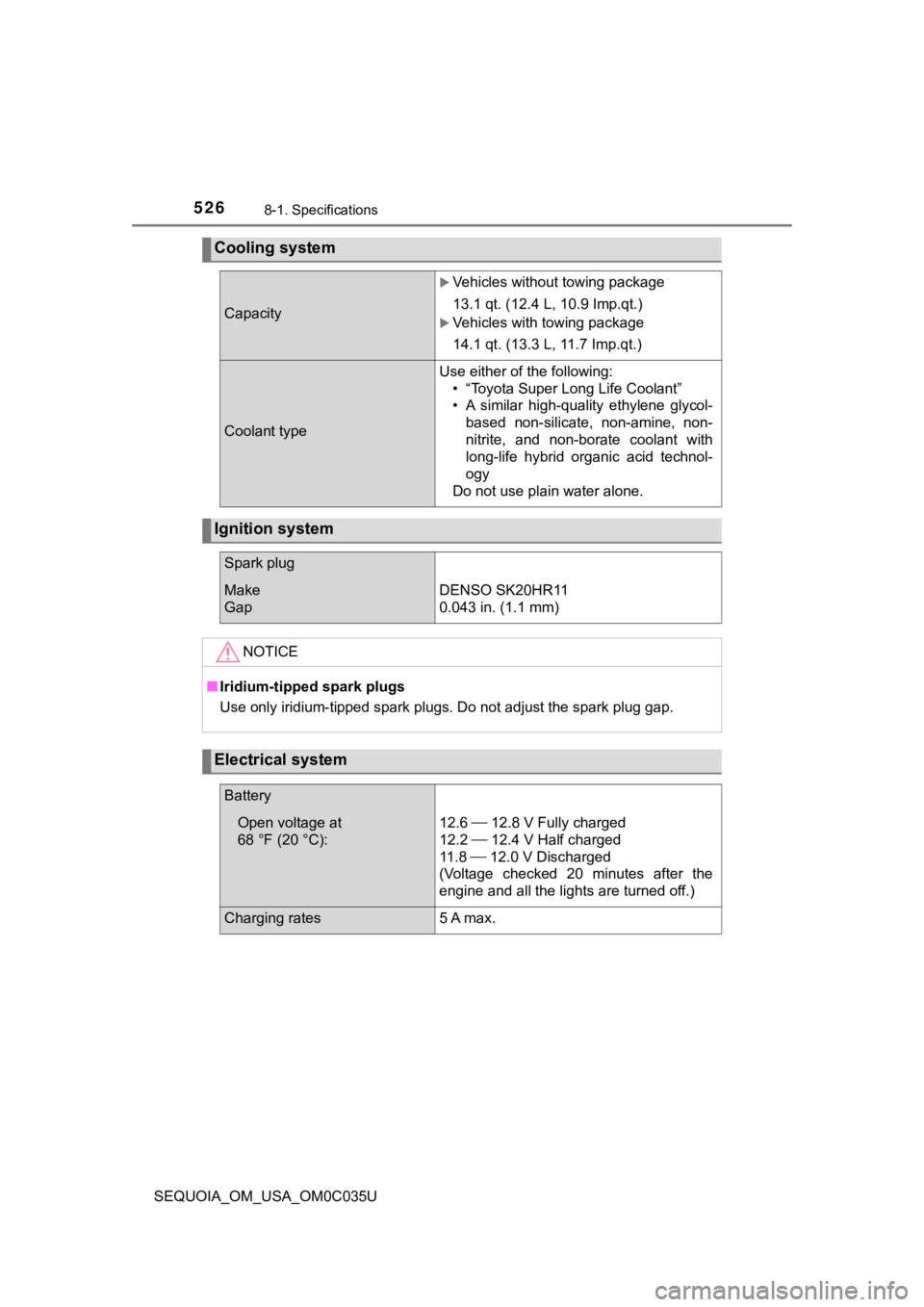
5268-1. Specifications
SEQUOIA_OM_USA_OM0C035U
Cooling system
Capacity
Vehicles without towing package
13.1 qt. (12.4 L, 10.9 Imp.qt.)
Vehicles with towing package
14.1 qt. (13.3 L, 11.7 Imp.qt.)
Coolant type
Use either of the following:• “Toyota Super Long Life Coolant”
• A similar high-quality ethylene glycol-
based non-silicate, non-amine, non-
nitrite, and non-borate coolant with
long-life hybrid organic acid technol-
ogy
Do not use plain water alone.
Ignition system
Spark plug
Make
GapDENSO SK20HR11
0.043 in. (1.1 mm)
NOTICE
■ Iridium-tipped spark plugs
Use only iridium-tipped spark plugs. Do not adjust the spark pl ug gap.
Electrical system
Battery
Open voltage at
68 °F (20 °C):12.6 12.8 V Fully charged
12.2 12.4 V Half charged
11 . 8 12.0 V Discharged
(Voltage checked 20 minutes after the
engine and all the lights are turned off.)
Charging rates5 A max.
Page 540 of 588

5408-1. Specifications
SEQUOIA_OM_USA_OM0C035U
Glossary of tire terminology
Tire related termMeaning
Cold tire inflation pres-
sure
Tire pressure when the vehicle has been
parked for three hours or more, or has not
been driven more than 1 mile or 1.5 km under
that condition
Maximum inflation
pressureThe maximum cold inflated pressure to which
a tire may be inflated, shown on the sidewall
of the tire
Recommended infla-
tion pressureCold tire inflation pressure recommended by a
manufacturer
Accessory weight
The combined weight (in excess of those stan-
dard items which may be replaced) of auto-
matic transmission, power steering, power
brakes, power windows, power seats, radio
and heater, to the extent that these items are
available as factory-installed equipment
(whether installed or not)
Curb weight
The weight of a motor vehicle with standard
equipment, including the maximum capacity of
fuel, oil and coolant, and if so equipped, air
conditioning and additional weight optional
engine
Maximum loaded vehi-
cle weight
The sum of:
(a) Curb weight
(b) Accessory weight
(c) Vehicle capacity weight
(d) Production options weight
Normal occupant
weight150 lb. (68 kg) times the number of occupants
specified in the second column of Table 1
*
that follows
Occupant distributionDistribution of occupants in a vehicle as speci-
fied in the third column of Table 1
* below
Page 579 of 588
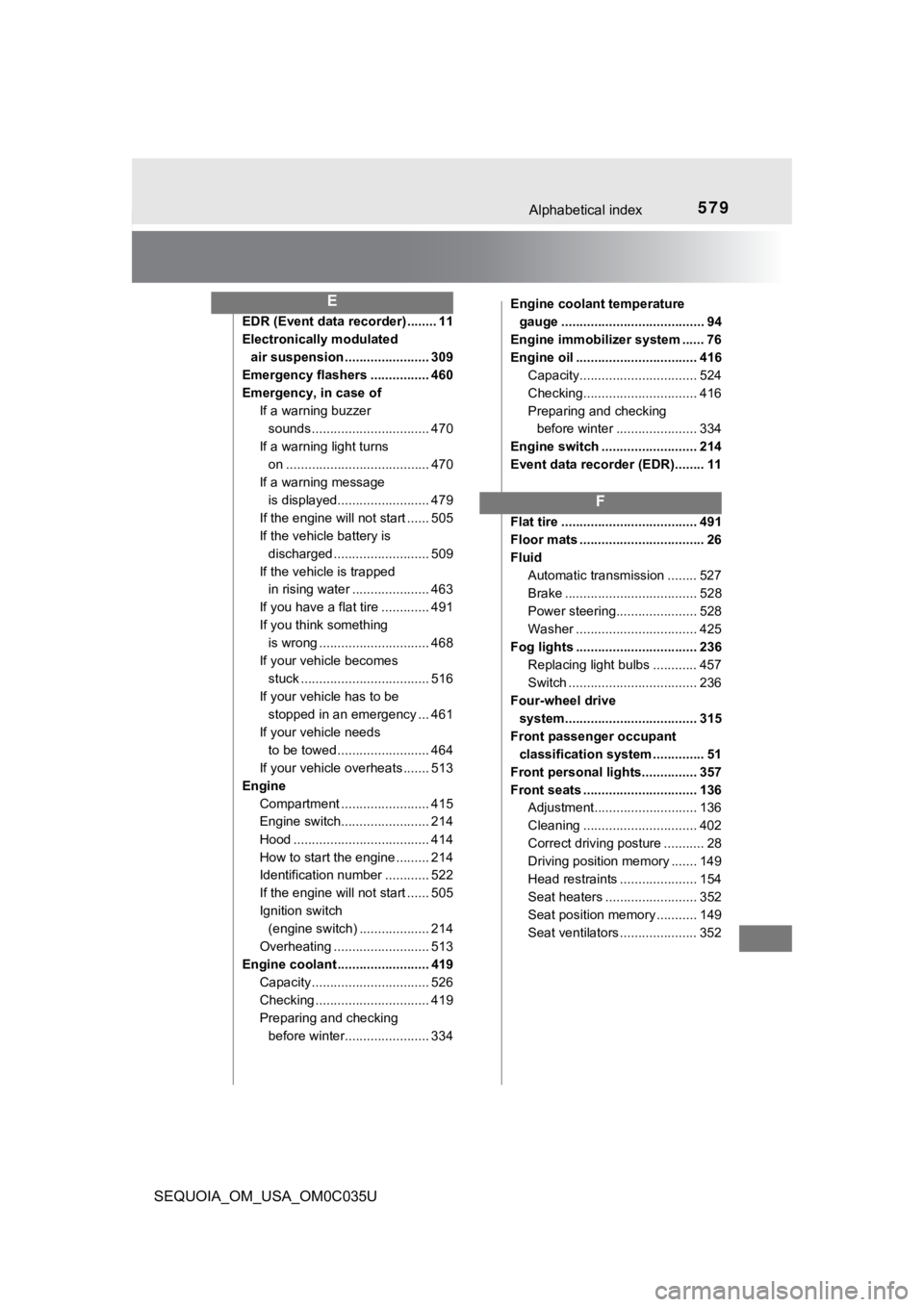
579Alphabetical index
SEQUOIA_OM_USA_OM0C035U
EDR (Event data recorder) ........ 11
Electronically modulated air suspension ....................... 309
Emergency flashers ................ 460
Emergency, in case of
If a warning buzzer sounds ................................ 470
If a warning light turns on ....................................... 470
If a warning message
is displayed......................... 479
If the engine will not start ...... 505
If the vehicle battery is discharged .......................... 509
If the vehicle is trapped in rising water ..................... 463
If you have a flat tire ............. 491
If you think something is wrong .............................. 468
If your vehicle becomes stuck ................................... 516
If your vehicle has to be
stopped in an emergency ... 461
If your vehicle needs to be towed ......................... 464
If your vehicle overheats ....... 513
Engine Compartment ........................ 415
Engine switch........................ 214
Hood ..................................... 414
How to start the engine ......... 214
Identification number ............ 522
If the engine will not start ...... 505
Ignition switch (engine switch) ................... 214
Overheating .......................... 513
Engine coolant ......................... 419 Capacity ................................ 526
Checking ............................... 419
Preparing and checking before winter....................... 334 Engine coolant temperature
gauge ....................................... 94
Engine immobilizer system ...... 76
Engine oil ................................. 416 Capacity................................ 524
Checking............................... 416
Preparing and checking before winter ...................... 334
Engine switch .......................... 214
Event data recorder (EDR)........ 11
Flat tire ..................................... 491
Floor mats .................................. 26
Fluid Automatic transmission ........ 527
Brake .................................... 528
Power steering...................... 528
Washer ................................. 425
Fog lights ................................. 236 Replacing light bulbs ............ 457
Switch ................................... 236
Four-wheel drive system.................................... 315
Front passenger occupant
classification system .............. 51
Front personal lights............... 357
Front seats ............................... 136 Adjustment............................ 136
Cleaning ............................... 402
Correct driving posture ........... 28
Driving position memory ....... 149
Head restraints ..................... 154
Seat heaters ......................... 352
Seat position memory ........... 149
Seat ventilators ..................... 352
E
F